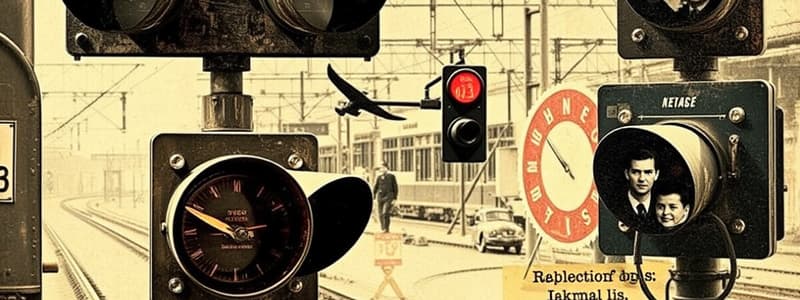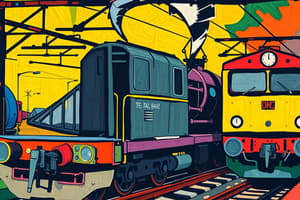Podcast
Questions and Answers
What does a Warner Signal at 'ON' indicate?
What does a Warner Signal at 'ON' indicate?
- Approach next signal cautiously (correct)
- Stop immediately
- Continue without restrictions
- Proceed at normal speed
The OFF aspect of a Warner signal indicates caution.
The OFF aspect of a Warner signal indicates caution.
False (B)
A 4-Aspect Colour Light Stop Signal at 'OFF' indicates the driver to stop the train.
A 4-Aspect Colour Light Stop Signal at 'OFF' indicates the driver to stop the train.
False (B)
A UQMA signal and a MACL signal have the same aspect and indication.
A UQMA signal and a MACL signal have the same aspect and indication.
What does a yellow aspect indicate?
What does a yellow aspect indicate?
What is indicated when a distant signal in single distant territory displays a proceed aspect?
What is indicated when a distant signal in single distant territory displays a proceed aspect?
A minimum of one stop Signal and a __________ Signal is necessary to provide the requisite space interval between the trains.
A minimum of one stop Signal and a __________ Signal is necessary to provide the requisite space interval between the trains.
What does a Warner signal at OFF indicate?
What does a Warner signal at OFF indicate?
Match the following signals with their indications:
Match the following signals with their indications:
What is the purpose of the attention aspect in a 4-Aspect Stop Signal?
What is the purpose of the attention aspect in a 4-Aspect Stop Signal?
A __________ marker shall be provided below UQ distant signal.
A __________ marker shall be provided below UQ distant signal.
All signals at a station must be located at the departure end only.
All signals at a station must be located at the departure end only.
A Warner signal and a distant signal perform the same function.
A Warner signal and a distant signal perform the same function.
What is the possible maximum number of aspects in LQ signal?
What is the possible maximum number of aspects in LQ signal?
What must a driver expect when a distant signal is at Green (OFF)?
What must a driver expect when a distant signal is at Green (OFF)?
The driver must approach a signal with a yellow aspect at a __________ speed.
The driver must approach a signal with a yellow aspect at a __________ speed.
A Warner signal on an independent post at ON provides information regarding signals in advance.
A Warner signal on an independent post at ON provides information regarding signals in advance.
Match the following signals with their indications:
Match the following signals with their indications:
How many total aspects are in a distant signal in double distant signal territory?
How many total aspects are in a distant signal in double distant signal territory?
What does a green aspect display on a distant signal indicate?
What does a green aspect display on a distant signal indicate?
The normal aspect of a distant signal in double distance territory is caution.
The normal aspect of a distant signal in double distance territory is caution.
If a distant signal in single distant territory displays a proceed aspect, then it indicates _____
If a distant signal in single distant territory displays a proceed aspect, then it indicates _____
If a distant signal in double distant territory displays a proceed aspect, then it indicates _____
If a distant signal in double distant territory displays a proceed aspect, then it indicates _____
Who should be able to see the aspects of signals clearly?
Who should be able to see the aspects of signals clearly?
What should not be compromised in signal location?
What should not be compromised in signal location?
Signals should normally be located on the right-hand side of the line they apply to.
Signals should normally be located on the right-hand side of the line they apply to.
Match the following signal aspects with their meanings:
Match the following signal aspects with their meanings:
What is a critical design aspect of signals concerning potential failure?
What is a critical design aspect of signals concerning potential failure?
Which of the following is NOT a consideration in signal location?
Which of the following is NOT a consideration in signal location?
Where must the Routing Signal be placed?
Where must the Routing Signal be placed?
The Starter Signal must be placed at least 400 meters in advance of the Home Signal.
The Starter Signal must be placed at least 400 meters in advance of the Home Signal.
What is the minimum distance for an Advanced Starter from the outermost point on a single line?
What is the minimum distance for an Advanced Starter from the outermost point on a single line?
The Intermediate Starter shall be placed in rear of the point or __________ to which it protects.
The Intermediate Starter shall be placed in rear of the point or __________ to which it protects.
Match the following types of signals with their descriptions:
Match the following types of signals with their descriptions:
If only one Starter is used for two or more converging lines, where should it be placed?
If only one Starter is used for two or more converging lines, where should it be placed?
What is the minimum height for a Warner signal when placed alone on a post?
What is the minimum height for a Warner signal when placed alone on a post?
The Warner signal can be taken 'OFF' while the stop signal above it is 'ON'.
The Warner signal can be taken 'OFF' while the stop signal above it is 'ON'.
What is the minimum distance a Warner signal can be placed from the first stop signal?
What is the minimum distance a Warner signal can be placed from the first stop signal?
The Home Signal must be located in rear of all connections, and close to the first set of facing points clear of the __________.
The Home Signal must be located in rear of all connections, and close to the first set of facing points clear of the __________.
Match the following signals with their characteristics:
Match the following signals with their characteristics:
What is the required minimum distance between the Outer Signal and Home Signal on a single line?
What is the required minimum distance between the Outer Signal and Home Signal on a single line?
Fixed Warner Signals may be adjusted to 'OFF' position for any line.
Fixed Warner Signals may be adjusted to 'OFF' position for any line.
What must be done if the distance between the Home Signal and the first facing point exceeds 180 metres?
What must be done if the distance between the Home Signal and the first facing point exceeds 180 metres?
An un-worked Warner Signal must be fixed at the __________ position.
An un-worked Warner Signal must be fixed at the __________ position.
Where must the Home Signal be located?
Where must the Home Signal be located?
Flashcards
Warner Signal at GREEN (OFF)
Warner Signal at GREEN (OFF)
Allows the train to proceed at normal speed.
Warner Signal at ON
Warner Signal at ON
Requires cautious approach to the next signal, prepare to stop.
Multiple Aspect Signalling
Multiple Aspect Signalling
Doesn't ensure exact information at station approaches, multiple signal aspects may be active.
Distant Signal at Green (OFF)
Distant Signal at Green (OFF)
Signup and view all the flashcards
4-Aspect Colour Light Stop Signal at OFF (green)
4-Aspect Colour Light Stop Signal at OFF (green)
Signup and view all the flashcards
Yellow aspect signal
Yellow aspect signal
Signup and view all the flashcards
Attention aspect
Attention aspect
Signup and view all the flashcards
Stop Signal
Stop Signal
Signup and view all the flashcards
Stop Signal Location
Stop Signal Location
Signup and view all the flashcards
Stop Signal Naming
Stop Signal Naming
Signup and view all the flashcards
Signal Visibility
Signal Visibility
Signup and view all the flashcards
Signal Placement (General)
Signal Placement (General)
Signup and view all the flashcards
Signal Sighting Distance
Signal Sighting Distance
Signup and view all the flashcards
Warner Signal Placement
Warner Signal Placement
Signup and view all the flashcards
Outer Signal
Outer Signal
Signup and view all the flashcards
Home Signal
Home Signal
Signup and view all the flashcards
Routing Signal
Routing Signal
Signup and view all the flashcards
Starter Signal
Starter Signal
Signup and view all the flashcards
Intermediate Starter & Advance Starter
Intermediate Starter & Advance Starter
Signup and view all the flashcards
Warner vs. Distant Signal
Warner vs. Distant Signal
Signup and view all the flashcards
Color Light Signals
Color Light Signals
Signup and view all the flashcards
Study Notes
Signal Aspects and Indications
- Warner Signal at Green (OFF) allows the driver to proceed at normal speed.
- Warner Signal at ON requires cautious approach to the next signal, preparing to stop.
- Multiple aspect signalling does not guarantee specific information at station approaches.
- Distant Signal at Green (OFF) informs the driver to expect the next stop signal to be OFF; subsequent stop signals may vary.
- 4-Aspect Colour Light Stop Signal at OFF (green light) permits the driver to proceed, indicating the next stop signal is also OFF.
- Yellow aspect signals caution; the driver must proceed with caution and prepare to stop at the next signal.
- Attention aspect is displayed by two yellow lights vertically, indicating to proceed but be ready for restricted speed due to upcoming conditions.
Signal Location and Requirements
- At least one stop signal and one permissive signal are necessary for safe train separation.
- Stop signals are strategically located at various points, such as approach and departure ends of stations and junctions.
- Naming of stop signals is essential to avoid confusion while identifying their locations and functions.
Location of Signals
- Signals must be positioned for optimal visibility and prevent misinterpretation of signals.
- Typically placed on the left-hand side of the tracks; alignment should avoid overlap with other light signals.
- Signals should have adequate sighting distances and operational efficiency, ensuring compliance with regulations.
- Warner Signals can be positioned on their own post or below the main stop signal, maintaining strict operational limitations.
Signal Types and Placement
- Warner Signal placement requirements include:
- 1200 meters behind the first stop signal.
- Positioned appropriately concerning other signals to ensure visual clarity.
- Outer Signal serves as the first stop signal, located at least 400 meters from potential line obstructions.
- Home Signal must be placed to provide adequate protection for adjacent lines, close to the first set of facing points.
- Routing Signal should be positioned in rear of the point it protects.
- Starter Signal should be at least 400 meters ahead of the Home Signal, with specific placements for converging lines.
- Intermediate Starter and Advance Starter placement is crucial, with specifications concerning their distances from connection points.
Review Questions
- Differences between Warner signal and Distant signal focus on their operational purposes and indications.
- Advantages of Colour Light Signals over Semaphore signals include clarity, visibility, and lower maintenance.
- True/False statements require understanding of signal functions, indicating potential common misconceptions.
- Fill-in-the-blank exercises emphasize knowledge of signaling territory and aspects relevant to signal operation.
Studying That Suits You
Use AI to generate personalized quizzes and flashcards to suit your learning preferences.




